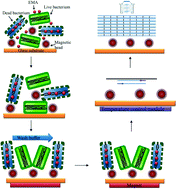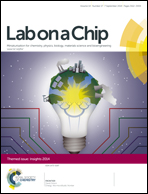Rapid isolation and diagnosis of live bacteria from human joint fluids by using an integrated microfluidic system†
Abstract
Arthroplasty is a general approach for improving the life quality for patients with degenerative or injured joints. However, post-surgery complications including periprosthetic joint infection (PJI) poses a serious drawback to the procedure. Several methods are available for diagnosing PJI, but they are time-consuming or have poor sensitivity and specificity. Alternatively, reverse-transcription PCR can detect live bacteria and reduce false-positive results but cannot avoid the cumbersome RNA handling and human contamination issues. In response, an integrated microfluidic system capable of detecting live bacteria from clinical PJI samples within 55 minutes is developed in this study. This system employs an ethidium monoazide (EMA)-based assay and a PCR with universal bacterial primers and probes to isolate and detect only the live bacteria that commonly cause PJI. The experimental results indicated that the developed system can detect bacteria in human joint fluids with a detection limit of 104 colony formation unit mL−1. Furthermore, nine clinical samples were analyzed using the microfluidic system. The results obtained from the microfluidic system were negative for all culture-negative cases, indicating that the proposed system can indeed reduce false-positive results. In addition, experimental results showed that the EMA sample pre-treatment process was crucial for successful detection of live bacteria. The culture-positive cases were diagnosed as positive by the proposed system only when the clinical samples were treated with EMA immediately after being sampled from patients. Based on these promising results, the developed microfluidic system can be a useful tool to detect PJI and potentially be applied in other clinical situations.


 Please wait while we load your content...
Please wait while we load your content...